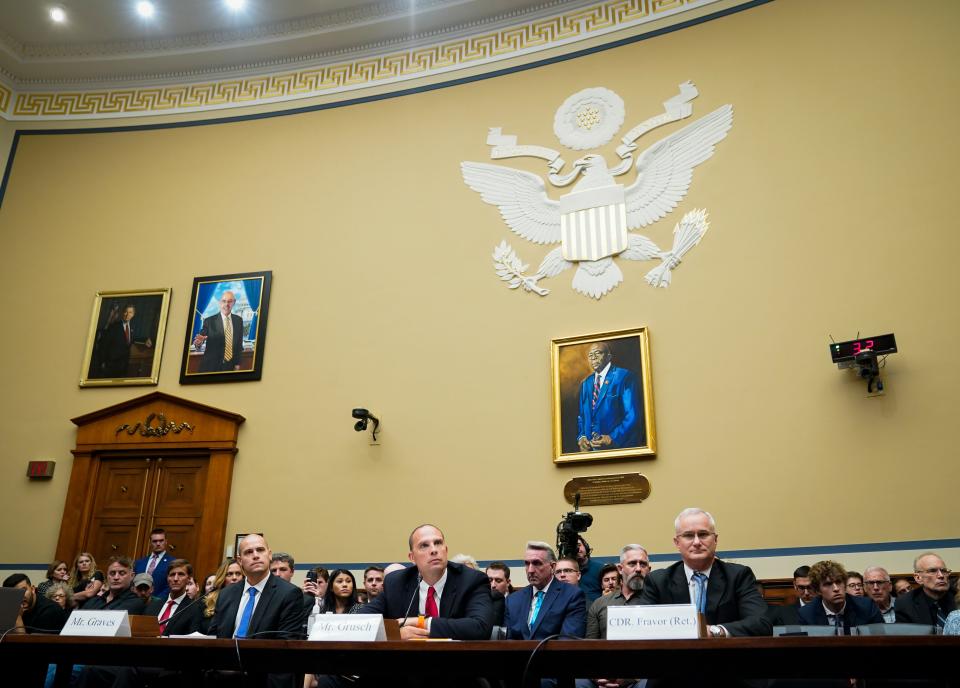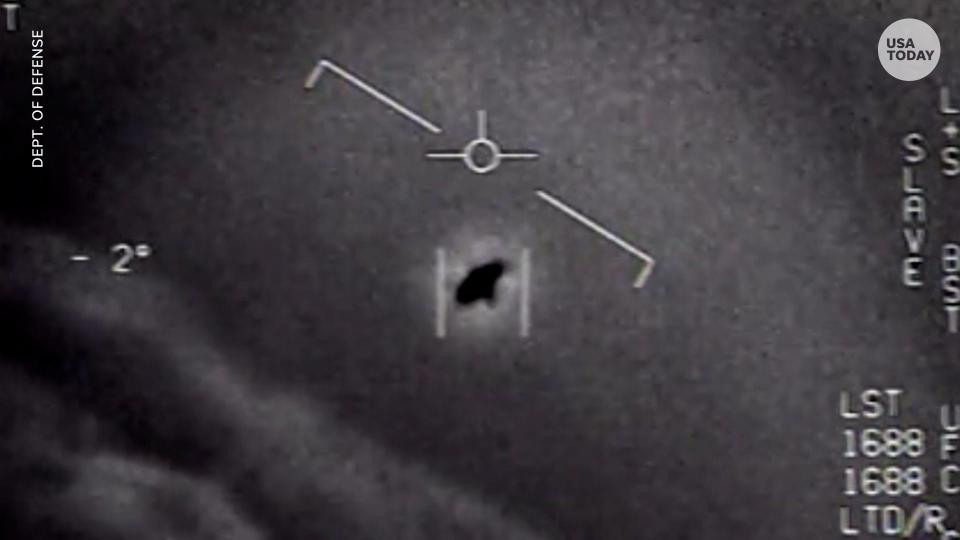UFO briefing takeaways: How NASA hopes to shift UAP talks 'from sensationalism to science'
- Oops!Something went wrong.Please try again later.
For those who were hoping NASA's UFO news briefing would uncover secrets about extraterrestrials, you may be disappointed.
No, there's still no evidence that alien spaceships have visited Earth, but on Thursday NASA vowed to continue studying the UFO phenomenon using new scientific techniques. In a long-awaited report, experts commissioned by the the space agency outlined ways in which NASA can partner with the U.S. government and private commercial organizations to better study and understand unidentified flying objects.
Long considered a fringe topic, UFOs have increasingly become part of the mainstream discussion as reports and videos of objects maneuvering in strange ways captivate the public.
Many of those reports can often be explained as balloons, drones and even commercial airplanes. But absent a commonplace terrestrial explanation, it's not uncommon for UFO enthusiasts to eagerly jump to the conclusion that otherworldly beings are visiting Earth.
'We have no explanation': See list of US states with the most reported UFO sightings
Because of the potential threat posed to national security and air safety, NASA embarked in 2022 on the space agency's first-ever study of UFOs, which the agency refers to as unidentified anomalous phenomena, or UAP. But NASA Administrator Bill Nelson said at a news briefing Thursday that the agency also set out to "shift the conversation surrounding UAP from sensationalism to science."
"There's a global fascination with UAP," Nelson said in prepared remarks. "We are looking for signs of life, past and present; it's in our DNA to explore and ask why things are the way they are."
No longer conspiracy theories: How UFOs became mainstream in America

Who is on the panel?
NASA commissioned an independent panel of 16 experts in June 2022 to examine data related to UAP.
Led by astrophysicist David Spergel, president of the Simons Foundation in New York City, the team was made up of some of the world’s leading scientists, data and artificial intelligence practitioners and aerospace safety experts.
After hosting a public panel in May, the team on Thursday released a comprehensive 36-page report of its findings. As promised, the report was not a review of previous UAP incidents.
Instead, the report detailed the reasons that data surrounding the study of UAP has previously been so insufficient while providing a roadmap on what possible data could be collected in the future. Grainy videos of unidentified objects may provide intrigue online, but without more detailed observations, the panel said that meaningful scientific conclusions about the nature of the objects remains impossible.
The report provided recommendations to create a uniform process by which NASA, other government agencies and commercial entities with satellites and other imaging technologies can gather and share data about "one of our planet's greatest mysteries," NASA Associate Administrator Nicola Fox said at the briefing.

Hunt for extraterrestrial life: Metallic spheres found on Pacific floor are interstellar in origin, Harvard professor claims
UFOs become more mainstream as stigma lessens

The report comes at a time when UFOs have once again been capturing the public's attention.
In the U.S., bipartisan pressure has been mounting on the federal government and the military to release more information about what they know of UAP, which is also the official term the government uses instead of UFOs.
And just this week, a hearing in front of Mexican lawmakers included one UFO researcher presenting what he alleged were the mummified bodies of ancient aliens, a claim that has been disputed by scientists.
A July hearing, in which former U.S. Air Force intelligence officer David Grusch claimed his country has been aware of “non-human” activity since the 1930s, became Congress’ latest foray into UFOs. A year prior, Congress had held its first public hearing on UFOs in more than 50 years, bucking the government's longstanding public position that unidentified flying objects were not worth studying.
Grusch was joined by former Navy pilots Lt. Ryan Graves and Cmdr. David Fravor for a hearing filled with claims of mysterious objects sighted by Navy pilots and a government program to retrieve and study downed spacecraft. Laws regarding classified information would have constrained Grusch from presenting hard evidence to support the claims of such a crash retrieval program, which the Pentagon has denied exists.
On Thursday, Nelson expressed skepticism of Grusch's claims and rebuked questions about whether NASA or other government agencies would ever cover up evidence of extraterrestrial life on earth.
"There's so much concern that something is locked up, classified, that the American government is not being open," Nelson said in response to a reporter's question. "Well, we are the American government and we are being open."
In a bid for transparency, the Pentagon's office to investigate UAP unveiled a website of its own this month where the public can access declassified information about reported sightings.

Life on Mars? Researchers find signs of rivers on Mars, a potential indicator of ancient life
What did NASA's report find?
That website, operated by the the All-domain Anomaly Resolution Office (AARO), will also be a place where both U.S. government and military personnel, as well as civilians, can someday soon make reports of UFO sightings.
However, NASA's convened panel also recommended that the space agency work closely with AARO to develop a standardized system for civilians to make UFO reports, which doesn't yet exist.
"NASA’s very involvement in UAP will play a vital role in reducing stigma associated with UAP reporting, which almost certainly leads to data attrition at present," according to the report.

Detecting UAP is often the result of happenstance, according to the report, which explained that sensors designed for other purposes are simply lucky to capture such objects at all. The report argued that NASA's fleet of Earth-observing satellites − largely unequipped to detect small UAP themselves − should be deployed to determine the environmental conditions present when such objects are sighted.
The report's authors further advocated for the use of artificial intelligence and machine learning technologies to identify occurrences of UAP.
Data from air traffic control towers and radar systems from the Federal Aviation Administration, as well as data from crowdsourcing tools such as open-source smartphone apps, could also provide valuable data, the report's authors contended.
"We know there's missing data," Spergel said Thursday.
'They touched my face': Actor Goldie Hawn recalls encounter with aliens while on Apple podcast
NASA appoints director of UAP research, but doesn't make name public
AARO was launched in 2022 a year after the Office of the Director of National Intelligence identified 144 military UAP encounters since 2004. That figure jumped this year to more than 500 military UAP reports, many of which cannot be explained as natural occurrences such as unpiloted aircraft or weather balloons.
But while strange objects in the sky can be captivating, experts at NASA, as well as other astrophysicists, have long cautioned that otherworldly explanations aren't likely even in the absence of a natural explanation. At a UFO hearing that NASA hosted in May, scientists were clear that they did not believe there was evidence to conclusively confirm that UAP are extraterrestrial in origin.
However, scientists haven't ruled such an explanation out, Nelson said.
"The top takeaway from the study is that there is a lot more to learn," Nelson said. "We don't know what these UAP are."
That's why NASA also announced Thursday that it appointed a director of UAP research – who it declined to name publicly – to manage data and coordinate with AARO and the Department of Defense.
"While today is a significant step for NASA it's not our final step," Nelson said. "Whatever we find, we will tell you."
Eric Lagatta covers breaking and trending news for USA TODAY. Reach him at elagatta@gannett.com.
This article originally appeared on USA TODAY: NASA UFO report: News, announcements from UAP press conference

